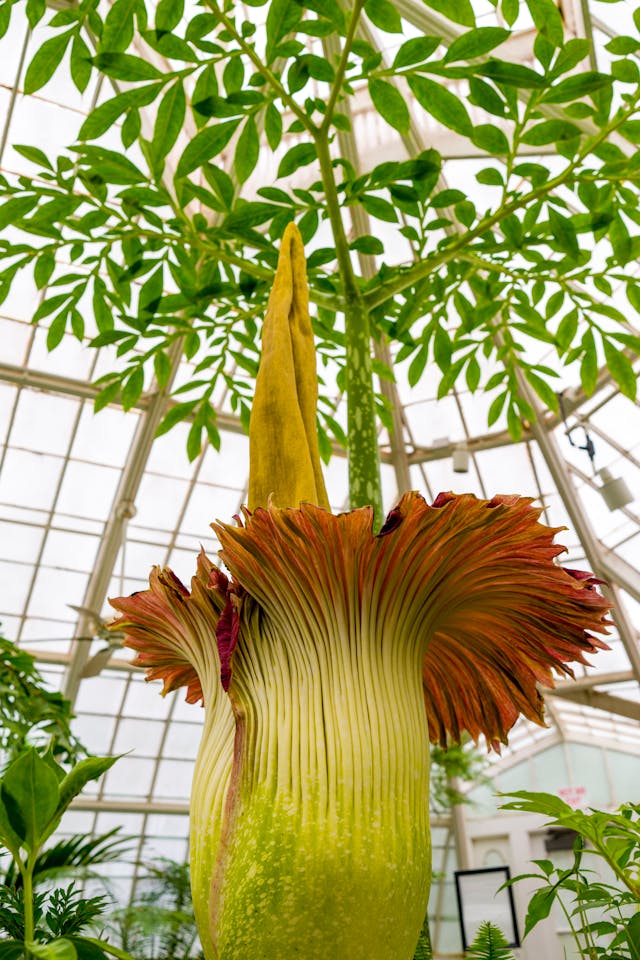
Why does the corpse plant smell so bad? They produce the scent of rotting meat to attract insects that feed and lay their eggs on decaying animals as pollinators.
“Corpse plant” is just a nickname. The flower’s real name is Amorphophallus titanium, which is made up of the three Greek words “amorphos” (misshapen), “phallos” (phallic), and “titan” (giant). So, instead of “corpse plant”, “giant misshapen phallus plant” would be more accurate.
The use of “giant” is not misplaced here because corpse plants are enormous. The underground part of the plant, known as a corm, can weigh 50 kg and the largest one ever found weighed 154 kg. The plants grow to about 3 m in height and their flowers have a diameter of about 1.6 m. They can grow even larger in the wild. The plant is native to western Sumatra, and they grow in rainforests that are on limestone hills. They were known about by the native people of Sumatra, but Europeans only discovered them in 1878. An Italian botanist called Odoardo Beccari found some of them when he was searching the rainforest. He sent some of the tubers home to Florence and they all died, but they did leave some seeds that have since been successfully incubated in a few botanic gardens around the world.
Corpse plants take a long time to flower, and they don’t flower very often. The plant has a complex lifecycle, and it can take over ten years from planting before they are ready to flower. The first stage is to plant the tuber in the ground. These are enormously heavy. The tuber stays dormant under the ground for a long period of time before sending up a huge leaf. This leaf can grow to be 6 m tall, and it separates into lots of other leaflets. They all photosynthesize, and the energy is sent down to the tuber for storage. After a year of a year and a half, the leaf dies and falls off. The tuber becomes dormant again. Then, after another long period of dormancy, the tuber sends up a long spike. This spike grows to about 3 m and then nothing happens for years. For the first flowering, it can take over ten years. Finally, when the plant has enough energy, the flower at the bottom of the spike opens. It releases its smell to attract pollinators, and then dies after about 36 hours. Many small berry-like fruits grow where the flower was and get eaten by birds. Then the tuber goes dormant again. The Chicago Botanic Garden planted several corpse plants in 2003 and the first one flowered in 2015.
So, why do the corpse flowers smell so bad? They have earned their nickname because they smell like a rotting corpse. They do this to attract flies and beetles, which are attracted to rotten flesh. Flies and beetles feed on the rotten flesh, but they also lay their eggs in it. That is why rotten meat becomes full of maggots. By targeting these specific pollinators, they can reduce competition with other flowers that target bees or butterflies.
The smell that is released by the flowers is a mix of several chemicals, some of which are dimethyl trisulfide (which smells like Limburger cheese – a very earthy, feety smell), dimethyl disulfide (which smells like garlic), trimethylamine (which smells like rotting fish), isovaleric acid (which is a smell you get in sweaty shoes and socks), benzyl alcohol (which is a sweet floral smell), phenol (which smells like throat sweets), and indole (which smells like feces). That’s quite a combination. The flowers live for 36 hours and they start to release the smell as soon as they bloom. The scent strengthens throughout the day and is strongest from late evening until the middle of the night, which is the time when these beetles and flies are most active and usually the time in a rainforest where the cool air carries the smell higher into the canopy. The flower has the ability to use stored energy to heat itself up to 37 ℃, this produces more of the odor and it also draws air up from below the plant in convection currents to carry the odor further. Being able to heat themselves up is a very rare ability in the plant world, but it works. A large number of flies and beetles come from far away and cluster into the plant, looking for the rotting meat. They are given some nectar, which leaves them happy, and they get covered in pollen before they fly off to another corpse plant. After about 36 hours, the flower withers and dies, and the fertilized plant starts to produce fruit. It may be another four years before it can flower again. And this is what I learned today.
Photo by frank minjarez: https://www.pexels.com/photo/plant-in-greenhouse-17601407/
Sources
https://en.wikipedia.org/wiki/Amorphophallus_titanum
https://www.jacksonvillezoo.org/blog/posts/what-makes-a-corpse-flower-smell-bad
https://www.chicagobotanic.org/titan/faq
https://www.chicagobotanic.org/sites/default/files/images/titan/Titan_arum_life_cycle.pdf
